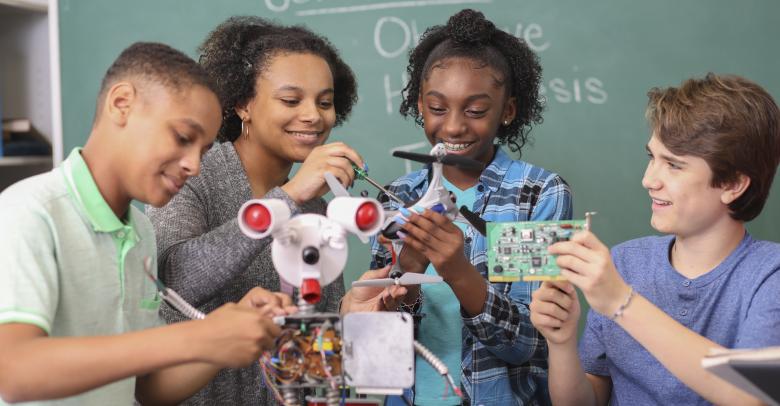Whether your school has a designated makerspace or you are integrating a makerspace into your own classroom, it’s important to get students excited about it. In order to help students to get the most out of the opportunity to use a makerspace, you may need to lay the foundation. Try these three methods to inspire your students to really engage with the makerspace and their opportunities to design and explore new ideas.
3 Ways to Inspire Students to Become Makers
At the very start of most great ideas is inspiration. These three activities can get the gears turning in students’ minds. Try one or all three to give students some jumping points to becoming active makers.
Share Historical Inspiration
Sharing the stories and inventions of historical makers may help students to see that even the most important inventions started out as a thought in a person’s mind. It also helps to highlight inventions that are incredibly important to society, but were invented by someone who may not be “well known”.
Here are 6 inventions and inventors who are not the most well-known, but who have benefited society with their ideas, designs, and innovations:
- Noah and Joseph McVicker – Play-Doh
- Ruth Graves Wakefield – Chocolate Chip Cookies
- George de Mestral – Velcro
- Ernie Fraze – Pop Tops on Soda Cans
- Joseph Friedman – Bendable Straws
- Mary Anderson – Windshield Wipers
Initiate a Classroom Challenge
If your students seem unsure of how they want to use a makerspace, start them off with a class-wide innovation assignment. A lesson plan that incorporates a need to plan, design, and create a solution to a problem is a great start:
Before you begin, it’s important to help students to understand The Engineering Cycle. To learn more about the difference between The Engineering Cycle and The Scientific Process, follow the link below:
Read more: Engineering Design Process vs Scientific Method
Example STEM Project: Harvesting the Wind
The goal of this project is to design, build and test a working model of a wind turbine that can generate the most electricity with a medium wind speed.
Students will identify the need, ask questions and do research, specify the requirements for their design, and then build, test, and evaluate it. By following the process from beginning to end, students will become more familiar with the maker mindset, and be able to more easily transfer the knowledge to their next project.
View the STEM Lesson Plan: Harvesting the Wind
Be a Model Maker
If you have the time and energy, get creative and share some of your maker abilities with the class. Inventions don’t need to be expensive or complicated, but sharing how you’ve found a need and then followed the Engineering Design Process to create a solution can be very inspiring for students who don’t know where to start.
Even a silly invention is a great way to show students that it’s the mindset and process that matter. Be sure to highlight designs or prototypes that were not successful and how you had to go through the process again to find a better solution. Failure is unavoidable, but students can be encouraged to keep trying if you model a positive way to engage with and move past failure as a maker.
Need more inspiration? Check out the following TED Talk titled “Why We Should Make Useless Things,” and see how a young inventor has come up with creative ways to solve problems.
a
More STEAM & STEM Inspiration & Ideas
If you’re looking for more inspiration and ideas, check out the other blogs in the STEAM & STEM category of our blog. Get your classroom of makers excited to work through the process and see their creativity and critical thinking skills in action. Also be sure to stop by the online store to find thousands of tools and supplies for a well-stocked makerspace.






Leave a Reply